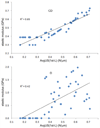Hyperlipidemia affects multiscale structure and strength of murine femur
- PMID: 24795172
- PMCID: PMC4141538
- DOI: 10.1016/j.jbiomech.2014.04.006
Hyperlipidemia affects multiscale structure and strength of murine femur
Abstract
To improve bone strength prediction beyond limitations of assessment founded solely on the bone mineral component, we investigated the effect of hyperlipidemia, present in more than 40% of osteoporotic patients, on multiscale structure of murine bone. Our overarching purpose is to estimate bone strength accurately, to facilitate mitigating fracture morbidity and mortality in patients. Because (i) orientation of collagen type I affects, independently of degree of mineralization, cortical bone׳s micro-structural strength; and, (ii) hyperlipidemia affects collagen orientation and μCT volumetric tissue mineral density (vTMD) in murine cortical bone, we have constructed the first multiscale finite element (mFE), mouse-specific femoral model to study the effect of collagen orientation and vTMD on strength in Ldlr(-/-), a mouse model of hyperlipidemia, and its control wild type, on either high fat diet or normal diet. Each µCT scan-based mFE model included either element-specific elastic orthotropic properties calculated from collagen orientation and vTMD (collagen-density model) by experimentally validated formulation, or usual element-specific elastic isotropic material properties dependent on vTMD-only (density-only model). We found that collagen orientation, assessed by circularly polarized light and confocal microscopies, and vTMD, differed among groups and that microindentation results strongly correlate with elastic modulus of collagen-density models (r(2)=0.85, p=10(-5)). Collagen-density models yielded (1) larger strains, and therefore lower strength, in simulations of 3-point bending and physiological loading; and (2) higher correlation between mFE-predicted strength and 3-point bending experimental strength, than density-only models. This novel method supports ongoing translational research to achieve the as yet elusive goal of accurate bone strength prediction.
Keywords: Collagen type I; High fat diet; Hyperlipidemia; Mouse bone; Multiscale finite element.
Copyright © 2014 Elsevier Ltd. All rights reserved.
Conflict of interest statement
Dr. Ascenzi holds patents licensed to Micro-Generated Algorithms, LLC, in which she holds an interest. The other authors are without conflicts of interest.
Figures







Similar articles
-
In situ parameter identification of optimal density-elastic modulus relationships in subject-specific finite element models of the proximal femur.Med Eng Phys. 2011 Mar;33(2):164-73. doi: 10.1016/j.medengphy.2010.09.018. Epub 2010 Oct 27. Med Eng Phys. 2011. PMID: 21030287 Free PMC article.
-
Elastic modulus varies along the bovine femur.J Mech Behav Biomed Mater. 2017 Jul;71:279-285. doi: 10.1016/j.jmbbm.2017.03.021. Epub 2017 Mar 27. J Mech Behav Biomed Mater. 2017. PMID: 28371701
-
Trabecular plates and rods determine elastic modulus and yield strength of human trabecular bone.Bone. 2015 Mar;72:71-80. doi: 10.1016/j.bone.2014.11.006. Epub 2014 Nov 15. Bone. 2015. PMID: 25460571 Free PMC article.
-
Finite element analysis of bone strength in osteogenesis imperfecta.Bone. 2020 Apr;133:115250. doi: 10.1016/j.bone.2020.115250. Epub 2020 Jan 22. Bone. 2020. PMID: 31981754 Free PMC article. Review.
-
On the Relation of Bone Mineral Density and the Elastic Modulus in Healthy and Pathologic Bone.Curr Osteoporos Rep. 2018 Aug;16(4):404-410. doi: 10.1007/s11914-018-0449-5. Curr Osteoporos Rep. 2018. PMID: 29869752 Review.
Cited by
-
Aging decreases osteocyte peri-lacunar-canalicular system turnover in female C57BL/6JN mice.Bone. 2024 Sep;186:117163. doi: 10.1016/j.bone.2024.117163. Epub 2024 Jun 8. Bone. 2024. PMID: 38857854 Free PMC article.
-
High Fructose and High Fat Exert Different Effects on Changes in Trabecular Bone Micro-structure.J Nutr Health Aging. 2018;22(3):361-370. doi: 10.1007/s12603-017-0933-0. J Nutr Health Aging. 2018. PMID: 29484349 Free PMC article.
-
Predicting mouse vertebra strength with micro-computed tomography-derived finite element analysis.Bonekey Rep. 2015 Apr 22;4:664. doi: 10.1038/bonekey.2015.31. eCollection 2015. Bonekey Rep. 2015. PMID: 25908967 Free PMC article.
-
PTH(1-34) effects on repairing experimentally drilled holes in rat femur: novel aspects - qualitative vs. quantitative improvement of osteogenesis.J Anat. 2017 Jan;230(1):75-84. doi: 10.1111/joa.12533. Epub 2016 Aug 15. J Anat. 2017. PMID: 27523886 Free PMC article.
-
Hyperlipidemia induced by high-fat diet enhances dentin formation and delays dentin mineralization in mouse incisor.J Mol Histol. 2016 Oct;47(5):467-74. doi: 10.1007/s10735-016-9691-2. Epub 2016 Aug 24. J Mol Histol. 2016. PMID: 27558143
References
-
- Adami S, Braga V, Zamboni M, Gatti D, Rossini M, Bakri J, Battaglia E. Relationship between lipids and bone mass in 2 cohorts of healthy women and men. Calcified Tissue International. 2004;74:136–142. - PubMed
-
- Ascenzi A. The micromechanics versus the macromechanics of cortical bone - a comprehensive presentation. Journal of Biomechanical Engineering. 1988;110:357–363. - PubMed
-
- Ascenzi A, Ascenzi M-G, Benvenuti A, Mango F. Pinching in longitudinal and alternate osteons during cyclic loading. Journal of Biomechanics. 1997;30:689–695. - PubMed
-
- Ascenzi A, Bonucci E. The tensile properties of single osteons. The Anatomical Record. 1967;158:375–386. - PubMed
-
- Ascenzi A, Bonucci E. The compressive properties of single osteons. The Anatomical Record. 1968;161:377–391. - PubMed
Publication types
MeSH terms
Substances
Grants and funding
LinkOut - more resources
Full Text Sources
Other Literature Sources

